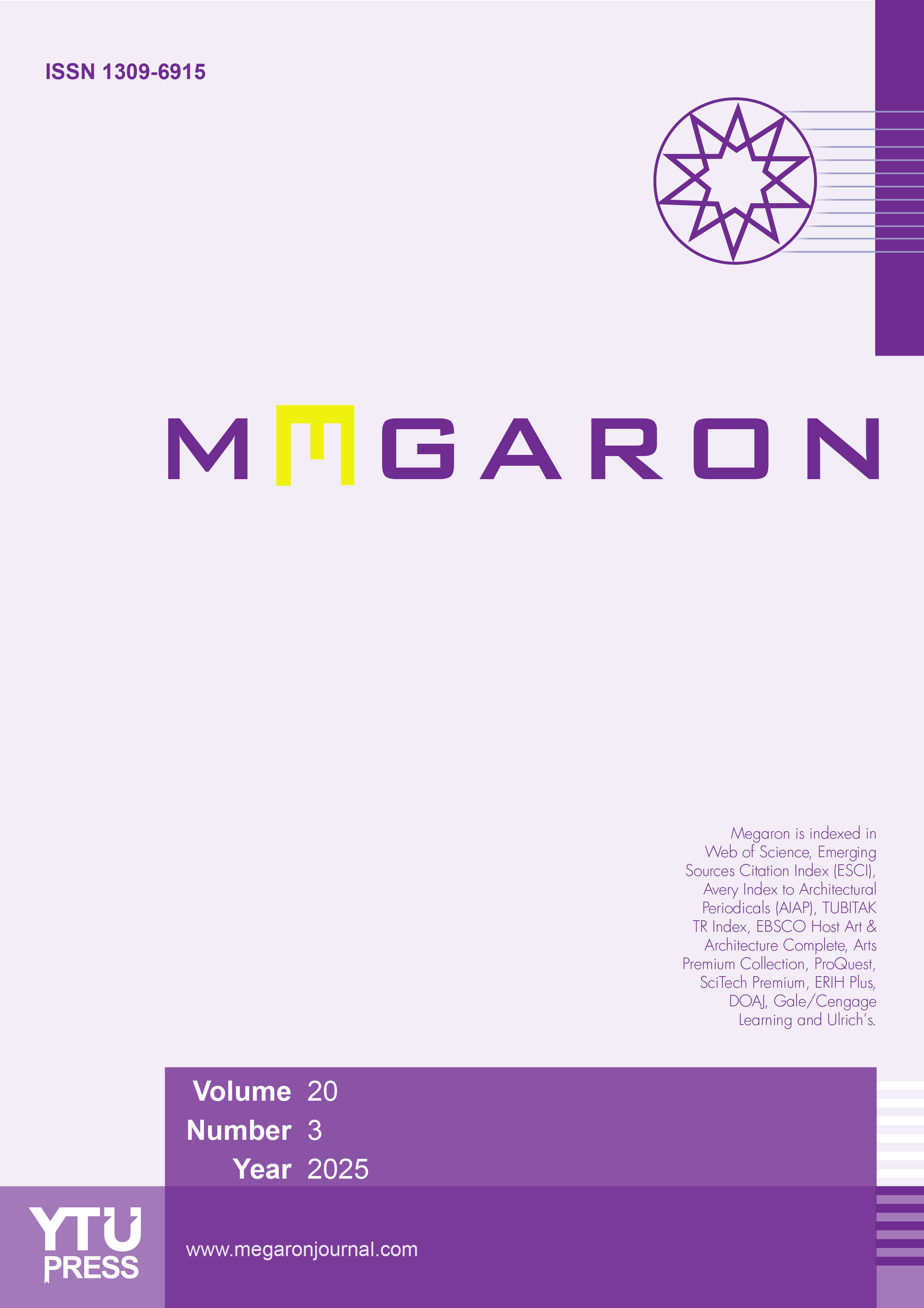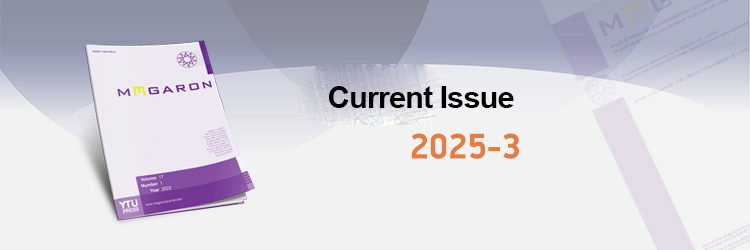Information For Authors
A. EDITORIAL POLICIES
As a scientific, international peer-reviewed journal, Megaron / Yıldız Technical University Faculty of Architecture E-Journal publishes national and international academic and original researches in architecture and planning that offer a certain contribution to related literature with definite methods and proved results. Articles, which can induce scientific discussions under current areas of interest of the field, are expected. However, data analysis, research summaries, technical reports, survey results, statistical works, compilation and articles produced from master’s thesis are not included in the scope. Megaron is published quarterly as web based, open access e-journal with E-ISSN: 1309-6915.
Manuscripts in English, which are not published previously or submitted elsewhere simultaneously, are welcomed. The submission of manuscripts to Megaron must be approved by all authors who acknowledge that the copyright is transferred to Deanship of Yıldız Technical University Faculty of Architecture if the manuscript is accepted for publication and the article cannot be published elsewhere in the same or any other language without consent.
All submissions are initially subject to review by editors and co-editors in terms of originality, contribution to literature, relevance to scope as well as technical issues such as linguistical / grammatical accuracy, referencing, etc. After this control, approved submissions are assigned to associate editors for reviewing process. Final decision is made by taking double blind peer review statements of at least two reviewers into consideration. The period before reviewing is completed in 30 days, results of reviewing are acquired in less than 120 days (including all decision steps) and a doi number is assigned for accepted manuscripts in 30 days.
Peer Review
Manuscripts submitted to Megaron will undergo a double-blind peer-review process. Each submission will be reviewed by at least two external, independent peer reviewers who are experts in their field in order to ensure an unbiased evaluation process. The editorial board will invite an external and independent editor to manage the evaluation process of manuscripts submitted by editors or by the editorial board members of the journal. The journal editors is the final authority in the decision-making process for all submissions.
Reviews are typically completed within one month of submission to the journal. Authors will be sent constructive reviewer comments intended to be useful. In general, the instructions, objections, and requests made by the reviewers should be followed. The revised manuscript should clearly and precisely indicate every step taken in accordance with the reviewers' notes. A list of responses and the corrections made to each comment should be provided.
Open Access Policy: All content is freely available; no fees are charged for full text access of published articles.
Articles published in MEGARON have the international license of (CC-BY-NC) "Creative Commons Attribution- NonCommercial 4.0". Accordingly, the authors who publish their articles in the journal are deemed to have accepted the following conditions:
- The author(s) retain the copyright of the article and give the journal the first publication right. The article is licensed under the Creative Commons Attribution license, which allows it to be shared by others, provided that the author(s) are specified and published first in this journal.
- The author(s) can make a separate agreement for the distribution of the published version in the journal of the article (such as sending to an institutional database or publication in a book) without giving full authorization.
- The author(s) can share the published version of the article on the corporate database or on their own websites. This can lead to efficient exchanges, earlier dissemination of the article and more citations. The final form of the manuscript has been seen and approved by all authors.
Open Access: Megaron is an open access journal which means that all content is freely available without charge to the user or his/her institution. Users are allowed to read, download, copy, distribute, print, search, or link to the full texts of the articles, or use them for any other lawful purpose, without asking prior permission from the publisher or the author. This is in accordance with the BOAI definition of open access.
Commons User Licenses: This work is licensed under a Creative Commons Attribution-Non Commercial 4.0 International License (CC BY-NC 4.0) .
Policy of Screening of Plagiarism: All submissions are subject to investigation in terms of plagiarism and / or unethical situations by the publisher’s office.
B. TYPES OF MANUSCRIPT
Research paper: These are manuscripts of an original research presented with its conceptual background, methods, results and discussion under 6000 words and can be published after double blind peer reviewing process.
Letter to the editor: These are manuscripts prepared to criticize a published article, text or hypothesis; to define a problem and discuss a current issue in various aspects based on a literature review in under 1000 words and can be published after editorial review. The letter must be clear and precise, the subject of discussion must bear a noteworthy importance.
Letter of opinion: These are manuscripts prepared to offer authors’ opinions on pros and cons of a hypothesis or scientific theory based on constructive criticism and supported with proofs to project a scientific argument that challenges the recent level of knowledge in a specific field in under 3000 words and can only be published after personal invitation.
C. INDEXING
Megaron is indexed by Web of Science (since 2016), Emerging Sources Citation Index (ESCI) (since 2016), Avery Index to Architectural Periodicals (AIAP) (since 2010), as “national peer reviewed journal” in ULAKBIM Social Sciences Databases by TUBITAK-TR Index (since 2010), EBSCO Host Art & Architecture Complete (since 2006), Arts Premium Collection (since 2006), ProQuest (since 2019), ProQuest Central Essentials (since 2019), ProQuest One Academic (since 2019), SciTech Premium (since 2019), ERIH PLUS (since 2019), DOAJ (since 2018), Gale/Cengage Learning (since 2011) and Ulrich’s (since 2014).
D. PREPARING THE MANUSCRIPTS
1. Abstract
Abstract includes the main problem, aims, scope, methods, original value, findings and results of the research in between 200 – 250 words with max five keywords that represent the research properly.
2. Main Text (word document)
Main text, which is structured under sequentially and hierarchically numbered sections and subsections, must not exceed 6000 words without abstracts, keywords and reference list. All tables and figures must be included in the mail text. Word shortcuts are discouraged. Notes must be numbered as [1], [2] to be listed at the end of the main text. All kind of information which may reveal author credentials must be avoided including any symbols, etc. that can be related to authors’ identity in tables and figures. For total anonymity which is the prerequisite of double-blind peer review, citing to previous works of authors must appear with concealed names of authors and publication in main text citations and reference list. These changes can be corrected after acceptance.
3. Referencing and Citations
References must appear in complete accordance with latest version of APA Style Referencing Guidelines in http://www.apastyle.org/ including upper and lower case and punctuation rules. The in-text citation must identify the cited work by surnames of authors and date of publication between parenthesis. Citing quoted verbatim text from another source must include page numbers. References must be listed alphabetically and for same authors chronologically.
4. Tables
The main text must include tables all of which must be sequentially numbered and separately uploaded as well. Tables must be attributed to the related text by using table numbers.
5. Figures
The main text must include figures (including maps and graphics) all of which must be sequentially numbered and separately uploaded as well. Figures must be 300+ dpi resolution, in RGB color palette, sized and cropped according to desired final published appearance. Figures must be attributed to the related text by using figure numbers. When necessary, cited visual materials must be presented with permission letter from copyright owner.
6. Application Letter
The subject of the work, the originality of the research and its contributions to related literature must be explained briefly in application letter which is addressed to editorial board and signed by all authors. Also, it must be clearly expressed that the manuscript (including the abstract) has not been published before and will not be sent elsewhere until the evaluation process in Megaron Journal is completed. You can download the template here*.
7. Title Page
Title page includes the title and type of the manuscript, word count (abstract, key words and references excluded), names, affiliations and institutions of all authors and information about funds / organizations (if any) that support the research. If the manuscript has been presented at a meeting before, the name, date and address of the meeting must be stated. If the manuscript has been produced from a PhD dissertation, information about the dissertation must be indicated. This page also includes the name, full address, phone number, fax number, mobile phone number and e-mail address of the corresponding author. You can download the template here*.
8. Copyright Form
You can download the template here*.
Manuscript Submission: Manuscripts can only be submitted to Megaron Journal online via Journal Agent System, which provides step by step guidance to users, by clicking “online manuscript submission” on www.megaronjournal.com web page, printed material sent via mail will not be accepted.
Similarity Report
Authors are required to obtain a similarity report for their manuscripts using any system such as iThenticate, Turnitin, or similar. This report must include limits for overall text similarity. Please note that while some similarity checking systems may incur a fee, authors affiliated with an institution (notably, most universities have agreements in place and provide access to these systems through their libraries) may be able to obtain these reports free of charge through their institution's subscription, or opt for a free system available in the market.










